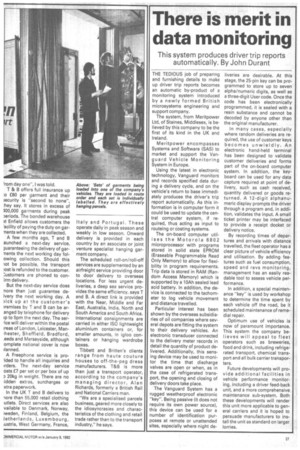There is merit in data monitoring
Page 21

If you've noticed an error in this article please click here to report it so we can fix it.
This system produces driver trip reports automatically. By John Durant
THE TEDIOUS job of preparing and furnishing details to make up driver trip reports becomes an automatic by-product of a monitoring system introduced by a newly formed British microsystems engineering and support company.
The system, from Meritpower Ltd, of Staines, Middlesex, is believed by this company to be the first of its kind in the UK and Ireland.
IVIeritpower encompasses Systems and Software (SAS) to market and support the Vanguard Vehicle Monitoring System in Europe.
Using the latest in electronic technology, Vanguard monitors and records specified data during a delivery cycle, and on the vehicle's return to base immediately produces the driver's trip report automatically. As this information is in computer form it could be used to update the central computer system, if required, thus, acting as input to routeing or costing systems.
The on-board computer utilises the Motorola 6802 microprocessor with programs stored in solid state EPROM (Eraseable Programmable Read Only Memory) to allow for flexibility in program requirements. Trip data is stored in RAM (Random Access Memory) which is supported by a 10Ah sealed lead acid battery. In addition, the device is connected to the tachometer to log vehicle movement and distance travelled.
Particular interest has been shown by the overseas subsidiaries of oil companies where several depots are fitting the system to their delivery vehicles. An electronic transducer connected to the delivery meter records in detail the quantity of product delivered. Additionally, this sensing device may be used to monitor the time that discharge valves are open or when, as in the case of refrigerated transport, the opening and closing of delivery doors take place.
The Vanguard System has a rugged weatherproof electronic "key". Being passive (it does not require its own power source), this device can be used for a number of identification purposes at remote or unattended sites, especially where night de liveries are desirable. At this stage, the 25-pin key can be programmed to store up to seven alpha/numeric digits, as well as a three-digit User code. Once the code has been electronically programmed, it is sealed with a resin substance and cannot be decoded by anyone other than the original manufacturer.
In many cases, especially where random deliveries are required, the use of customer keys becomes unwieldly. An electronic hand-held terminal has been designed to validate customer deliveries and forms part of the on-board computer system. In addition, the keyboard can be used for any data capture required at point of delivery, such as cash received, quantity delivered or goods returned. A 12-digit alphanumeric display prompts the driver through a program and, in addition, validates the input. A small ticket printer may be interfaced to provide a receipt docket or delivery notice.
By recording times of departures and arrivals with distance travelled, the fleet operator has a clear picture of vehicle efficiency and utilisation. By adding features such as fuel consumption, speed and revs monitoring, management has an easily readable tool to assess vehicle performance.
In addition, a special maintenance "key" is used by workshop to determine the time spent by each vehicle off the road, be it scheduled maintenance of remedial repair.
Optimum use of vehicles is now of paramount importance. This system the company believes will appeal to fleet operators such as breweries, food and drink, including refrigerated transport, chemical transport and all bulk carrier transporters.
Future developments will provide additional facilities in vehicle performance monitoring, including a driver feed-back unit, and a more comprehensive maintenance sub-system. Both these developments will render this unit more applicable to general carriers and it is hoped to persuade manufacturers to install the unit as standard on larger lorries.










































